‘What PSU do I Need’ is one of the most popular questions asked in the hardware community, especially from the users building their first PC or from beginners in the hardware field. PSU or commonly called as Power Supply is one of the most important components of any computer. It is the only component that provides power to all your internal components, i.e., CPU, motherboard, graphics card, etc.
The proper selection of PSU can be tricky for some users because it is available in different wattages and form factors. Also, there are some other factors involved that can significantly influence your decision in choosing a power supply. If you make the wrong decision in selecting the proper PSU, then you can face compatibility and instability issues with your computer. So, here I am going to tell you how you can choose the right PSU for your computer and what all factors are involved in it.
Main Factors to consider when buying a PSU
Below are the main factors that you must take into account when buying a power supply for your computer.
Size or Form Factor
The first thing to take into account when buying a PSU is to know which size power supply fits in your computer case. It is because power supplies come in different form factors or sizes. The most common PSU form factors for most computers include ATX/PSU, SFX, SFX-L, and TFX. The standard size PSU is referred to as ATX or PS2 power supply. Even in the standard PSU form factor, there are different variations in length as some PSUs are longer than the others while the width and the height remain the same.
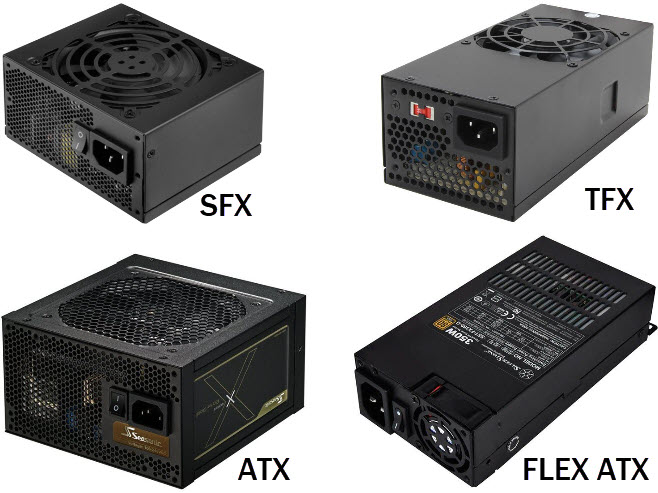
A standard ATX PSU is 150mm wide, 86mm in height, and the length can go from 140mm to up to 230mm. Small form factor power supplies include SFX, SFX-L, and TFX power supplies that are mostly used in slim and small form factor builds and cases. An SFX power supply is 125mm in width, 63mm in height, and 100mm in length while the SFX-L is longer and has a length of 130mm. On the other hand, a TFX power supply is 85mm in width, 65mm in height, and 175mm in length. Flex ATX is a PSU form factor that is used in server chassis and has dimensions of 81.5mm x 40.5mm x 150mm (W x H x L). So, it is essential to know your computer case form factor and the power supply supported by it before buying a PSU, because if you don’t then you will end up losing your hard-earned money as the PSU won’t fit in your case.
| Power Supply Form Factor | Dimensions (W x H x L) |
| Standard ATX or PS2 | 150mm x 86mm x 140mm to 230mm |
| SFX | 125mm x 63mm x 100mm |
| SFX-L | 125mm x 63mm x 130mm |
| TFX | 85mm x 65mm x 175mm |
| Flex ATX | 81.5mm x 40.5mm x 150mm |
Capacity or Wattage
The next most important thing to take into account is the capacity, power, or the Wattage of the power supply that you are going to need. Estimating the Wattage of the power supply can be a challenging and confusing task for some people because you have to guess or know about the total power consumption of your PC. It can be very difficult for novice users and beginners because they have to know about the power consumption of the hardware components present in their PC case. However, there are some tools and tricks that can help you know about the capacity of the power supply that you are going to require.
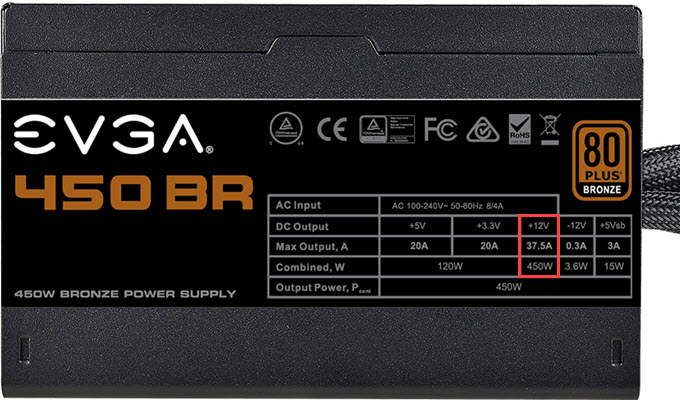
Using PSU Calculator – If you want a rough guess about the capacity of the power supply that you are going to need, then you can use online PSU calculator tools for it. Using these tools, you can select the components present in your computer case, and then by hitting the calculate button, it calculates the total power consumed by your PC at full load and recommends what Wattage PSU you need for your PC. In my experience, these tools work reasonably well, but sometimes they overestimate or underestimate the PSU Wattage to a significant extent. Also, sometimes, some of the components may not be listed in their database, which may lead to an inaccurate result and may render these tools somewhat useless in such situations.
 By Graphics Card Power Consumption – Another great way to predict the power supply wattage for your new PC is by looking at the PSU requirement of the graphics card because most of the time graphics card is the most power-hungry component in any PC. For example, if you are building a PC with GeForce GTX 1660 Ti graphics card, then the recommended power supply for it is 450W. Here, you can add an extra 50W to it to be on the safe side and can get a 500W PSU for your system. This method works pretty well, even for a system with a budget graphics card. However, if you don’t have a discrete graphics card and use integrated or onboard graphics for display, then in most cases a good 400W power supply is enough even if you have a high-end processor.
By Graphics Card Power Consumption – Another great way to predict the power supply wattage for your new PC is by looking at the PSU requirement of the graphics card because most of the time graphics card is the most power-hungry component in any PC. For example, if you are building a PC with GeForce GTX 1660 Ti graphics card, then the recommended power supply for it is 450W. Here, you can add an extra 50W to it to be on the safe side and can get a 500W PSU for your system. This method works pretty well, even for a system with a budget graphics card. However, if you don’t have a discrete graphics card and use integrated or onboard graphics for display, then in most cases a good 400W power supply is enough even if you have a high-end processor.
Below for GeForce GTX 1080
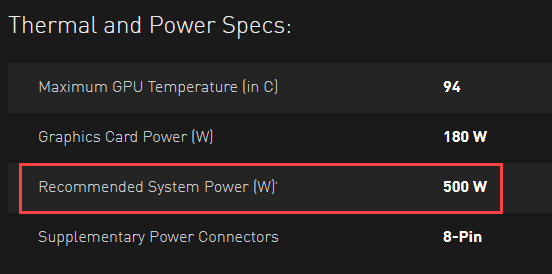
Important Tip: It is always better to get PSU with a slightly higher Wattage than you would normally require instead of getting an underpowered PSU. It is because if you get an underpowered PSU, then you may face instability issues, and it can also result in PSU burnout in some cases.
Check out: How to Find the Right PSU for your Graphics Card
Importance of 12V Rail
The best way to judge a power supply power output is by checking the amount of current present on the 12V Rail. It is due to the fact that 12V Rail is the most important voltage rail in the power supply because it supplies power to all the major components in your PC including a processor, graphics card, hard drive, fans, etc. The product of the current and voltage present on the 12V Rail should be almost equal to the rated Wattage of the PSU. In case, if the PSU has multiple 12V Rails, then the product of the individual 12V Rails and its current should be added, which should also come close to the rated power of the PSU in Watts. For example, Corsair CX650 has a rated Wattage of 650W and comes with a single 12V rail. The current present on its 12V Rail is 54A, and if we multiply it, then it comes out to be 12 x 54 = 648W, which is roughly the same as its advertised capacity.
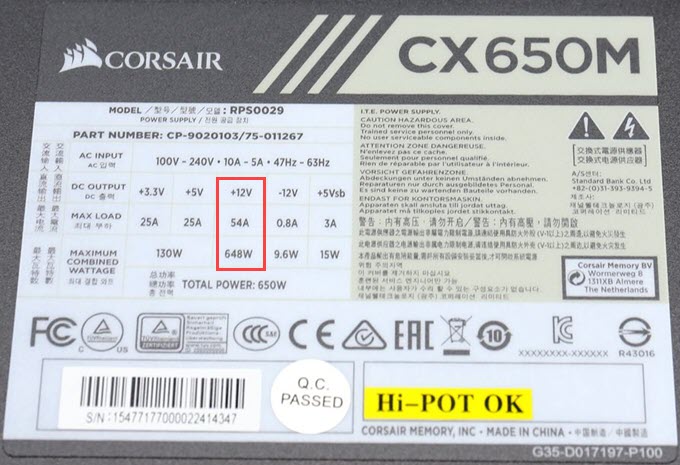
PCIe Power Connectors
Make sure that the power supply you are getting comes with at least one 8-pin (6+2) PCIe connector to power a budget to a mid-range graphics card. If you are getting a 500W or higher PSU, then it is advisable to get a power supply with two 8-pin (6+2) PCIe power connectors for running a powerful mid-range to a high-end graphics card.

Modular vs. Non-Modular
The modular power supply has a detachable cable, which means you can remove or add peripheral and other power cables based on your requirements. Modular power supplies are also of two types: semi-modular and fully modular. The semi-modular power supply has a fixed motherboard cable (24-pin) and sometimes CPU power cable (8-pin) while the peripheral and PCIe power cables are detachable. In a fully modular power supply, all cables are removable, and you can add custom power cables to it based on your requirements including the color and length of the cable/wire. Most of the mid-range and high-end power supplies come with a modular design. The main advantage of a modular power supply is that it allows better cable management and gives your build a cleaner look. Moreover, you can add customized power cables of different colors and lengths so that they match your system theme. A non-modular power is one that has all non-detachable cables. Almost all the budget and mainstream power supplies in the market are non-modular, which means they come with fixed cables.
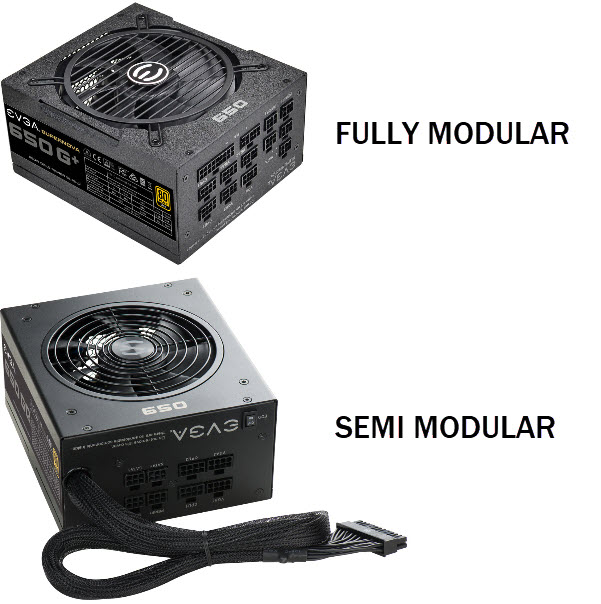
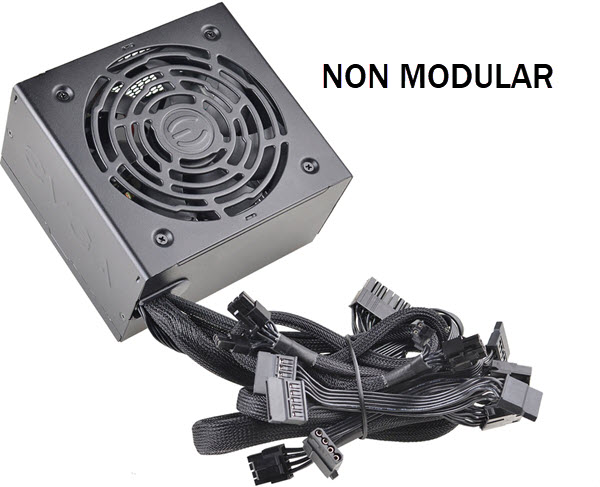
Efficiency [80 Plus Certification]
Efficiency is also an important factor that comes into play when shopping for a power supply. The efficiency of a PSU is denoted by the 80 Plus Certification Rating which has six levels. The first or the lowest level is the 80 Plus White, and then comes the 80 Plus Bronze, 80 Plus Silver, 80 Plus Gold, 80 Plus Platinum, and 80 Plus Titanium, which is the highest rating. A power supply with a higher 80 Plus Certification rating will have higher efficiency and consumes less power than its lower counterpart with the same Wattage. The higher the efficiency of a PSU, the lesser will be your electrical bill and the heat generation. The 80 Plus certification for a power supply is only given when it has an energy efficiency of 80% or more at 20%, 50%, and 100% of the rated load, and a power factor of 0.9 (Active PFC) or higher at 100% load. Below, you can see the various 80 Plus certification ratings at different loads for a power supply.
Protection Features & Braided Cables
Make sure that the power supply you are getting comes with basic or essential protection features so that it can protect your components against abnormal voltage/current variations or power surges. These protection features include OVP (Over Voltage Protection), UVP (Under Voltage Protection), OCP (Over Current Protection), OPP (Over Power Protection), SCP (Short Circuit Protection), and OTP (Over Temperature Protection). It is also good to have braided cables as they protect the wires against damage and cuts and also give the PSU a premium touch.
Operating Temperature
You may also want to check out the operating temperature of a PSU if you live in a hotter region because the chances of failure of your power supply become more pronounced if the PSU temperature exceeds its operating temperature. For hotter areas, make sure that the power supply has an operating temperature in the range of 0° to 40° C or 0° to 50° C. You can find this operating temperature data in the technical specifications of the PSU on its official website.
Budget
Well, the budget is also one of the most important factors when you are buying a power supply. Even if you have a tighter budget, then also you should try to get a decent branded PSU with the right capacity, and don’t ever settle for a Chinese or non-branded PSU because it will do more harm than good. So, it is better to up your budget and get a decent power supply if you want your components to be safe.
Check out: Best Budget Power Supply for Gaming or Work PC
See also:
- How to Test a Power Supply of a PC
- Fix PSU Fan Not Spinning Problem
- Should I upgrade my PSU after upgrading the GPU?
- PSU Fan Up or Down? Find the Right PSU Fan Orientation
- How to Find out the Details of the PSU installed in your PC?
Queries?
If you still have queries regarding which PSU to buy for your PC, then you can ask them in the comment section below.
(*This post may contain affiliate links, which means I may receive a small commission if you choose to purchase through the links I provide (at no extra cost to you). Thank you for supporting the work I put into this site!)
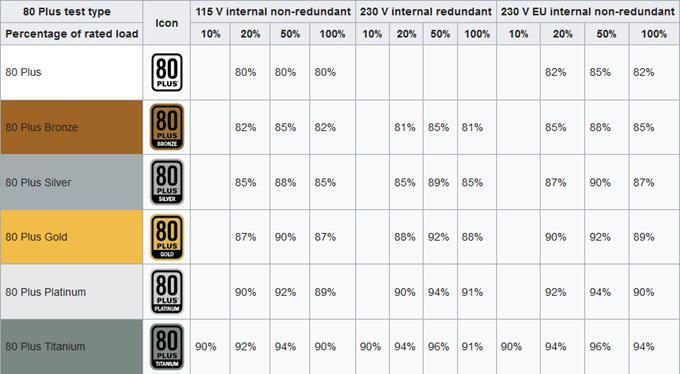
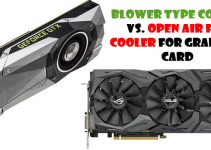
![Is My Hard Drive about to Fail [Top Symptoms of HDD Failure] Is My Hard Drive about to Fail [Top Symptoms of HDD Failure]](https://graphicscardhub.com/wp-content/uploads/2022/11/hard-drive-failure-symptoms-211x150.jpg)
![Technical Terms Related to Graphics Cards [Must Read] Technical Terms Related to Graphics Cards [Must Read]](https://graphicscardhub.com/wp-content/uploads/2017/10/graphics-card-terms-211x150.jpg)